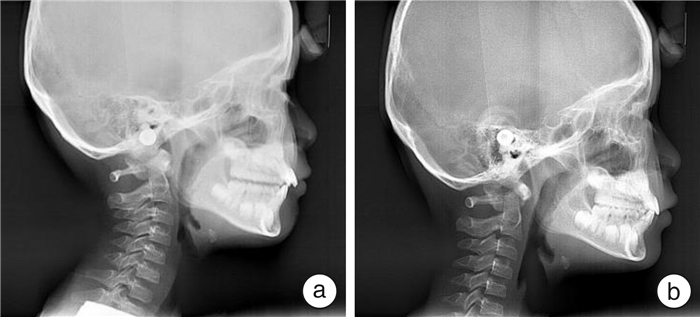The efficacy of muscle function training combined with occlusal inducer in the treatment of malocclusion in children with OSA
-
摘要: 目的 探讨肌功能训练联合咬合诱导器在阻塞性睡眠呼吸暂停(obstructive sleep apnea,OSA)儿童术后牙列不齐治疗中的临床效果。方法 选取2020年1月—2021年12月就诊于上海交通大学医学院附属上海儿童医学中心耳鼻喉口腔颌面外科OSA术后40例患儿,分为治疗组(20例)和对照组(20例),治疗组通过肌功能训练联合咬合诱导器,对照组仅行肌功能训练。比较两组头影测量硬组织术前、术后12个月的数值变化及术前、术后6、12个月儿童阻塞性睡眠呼吸暂停18项生活质量调查表(OSA-18)评分。结果 ① 两组患者术后12个月睡眠障碍、身体症状、情绪状况、白天嗜睡和精力状态及对监护人的影响程度均得到明显改善(P<0.05),治疗组在睡眠障碍、身体症状、情绪状况、对监护人的影响程度的评分优于对照组(P<0.05);②术后12个月头影测量数据显示:治疗组术后12个月的上下齿槽座角(ANB)、覆
-
Key words:
- muscle function training /
- occlusal inducers /
- obstructive sleep apnea /
- malocclusion
-

-
表 1 肌功能训练内容
练习内容 方法 时间/次数 具体内容 唇肌训练 包唇训练 2 min/组,5组/d 上、下唇红完全包裹在一起,持续10 s/次 舌肌训练 N点训练 5 min/组,3组/d 上切牙后5 mm,舌尖顶在切牙乳突(N点),保证唇肌无运动,每次保持10 s 吞咽训练 喝水训练 50口/组,2组/d 喝一口水,吞咽时舌尖放置切牙乳突的位置,每次持续10 s,连续50口 咬肌训练 咬肌练习 10 min/组,2组/d 双手触之下颌角,咬紧后牙,可触摸凸出的咬肌,每次持续10 s 表 2 两组OSA患儿手术前后OSA-18问卷调查分析
X±S 分组 总分 睡眠障碍 术前 术后6个月 术后12个月 术前 术后6个月 术后12个月 治疗组 76.47±7.81 41.82±6.84 33.47±3.61 17.59±2.45 7.88±1.36 5.47±1.23 对照组 76.12±7.87 45.24±6.51 40.88±5.87 18.35±2.52 10.94±2.63 6.71±2.20 P 0.445 0.057 <0.01 0.170 <0.01 <0.05 分组 身体症状 情绪状况 术前 术后6个月 术后12个月 术前 术后6个月 术后12个月 治疗组 20.29±2.97 9.29±1.21 5.35±1.05 14.88±2.47 8.76±1.82 5.71±1.49 对照组 20.12±3.08 11.18±1.97 8.06±1.81 15.06±2.72 9.94±1.02 7.06±1.19 P 0.43 <0.01 <0.01 0.417 <0.01 <0.01 分组 白天嗜睡和精力状态 对监护人的影响 术前 术后6个月 术后12个月 术前 术后6个月 术后12个月 治疗组 10.35±2.37 6.59±2.12 5.71±1.49 18.00±2.37 10.12±2.59 8.41±1.69 对照组 10.53±2.18 6.19±2.12 6.24±2.16 17.94±2.33 10.35±2.47 9.53±2.09 P 0.402 0.276 0.187 0.468 0.387 <0.05 表 3 术前、术后12个月头影测量硬组织变化
X±S 组别 例数 SNA/° SNB/° 治疗前 治疗后 治疗前 治疗后 治疗组 20 79.85±2.37 81.80±0.67 73.46±2.12 74.95±1.33 对照组 20 80.52±4.51 81.17±3.52 73.88±3.65 74.14±3.02 P 0.280 0.218 0.326 0.140 组别 例数 ANB/° MP-FH/° 治疗前 治疗后 治疗前 治疗后 治疗组 20 7.26±1.35 5.40±0.40 28.38±9.74 29.05±4.38 对照组 20 7.41±1.60 7.45±3.53 27.98±5.14 28.31±5.11 P 0.367 <0.01 0.436 0.313 组别 例数 覆 
L1-MP/° 治疗前 治疗后 治疗前 治疗后 治疗组 20 3.59±2.31 0.65±2.31 89.28±8.76 92.36±7.62 对照组 20 3.46±1.54 2.73±1.56 91.13±8.61 91.23±5.35 P 0.418 <0.01 0.252 0.296 组别 例数 U1-L1/° 覆盖/mm 治疗前 治疗后 治疗前 治疗后 治疗组 20 137.12±13.06 116.52±23.75 6.12±0.90 3.34±0.59 对照组 20 139.65±9.85 137.15±10.10 5.80±1.34 5.43±1.49 P 0.247 <0.01 0.190 <0.01 -
[1] Savini S, Ciorba A, Bianchini C, et al. Assessment of obstructive sleep apnoea(OSA)in children: an update[J]. Acta Otorhinolaryngol Ital, 2019, 39(5): 289-297. doi: 10.14639/0392-100X-N0262
[2] 倪鑫. 中国儿童阻塞性睡眠呼吸暂停诊断与治疗指南(2020)[J]. 中国循证医学杂志, 2020, 20(8): 883-900. https://www.cnki.com.cn/Article/CJFDTOTAL-ZZXZ202008005.htm
[3] Gulotta G, Iannella G, Vicini C, et al. Risk Factors for Obstructive Sleep Apnea Syndrome in Children: State of the Art[J]. Int J Environ Res Public Health, 2019, 16(18): 3235. doi: 10.3390/ijerph16183235
[4] Kang M, Mo F, Witmans M, et al. Trends in Diagnosing Obstructive Sleep Apnea in Pediatrics[J]. Children (Basel), 2022, 9(3): 306.
[5] Marchese MR, Scarano E, Rizzotto G, et al. The role of masseter muscle EMG during DISE to predict the effectiveness of MAD: preliminary results[J]. Acta Otorhinolaryngol Ital, 2016, 36(6): 486-489. doi: 10.14639/0392-100X-1474
[6] 郭靖晗, 李远远, 刘月华. 儿童阻塞性睡眠呼吸暂停低通气综合征治疗的研究进展[J]. 复旦学报(医学版), 2020, 47(5): 783-788. doi: 10.3969/j.issn.1672-8467.2020.05.022
[7] Yanyan M, Min Y, Xuemei G. Mandibular advancement appliances for the treatment of obstructive sleep apnea in children: a systematic review and meta-analysis[J]. Sleep Med, 2019, 60: 145-151. doi: 10.1016/j.sleep.2018.12.022
[8] Gu M, Savoldi F, Hägg U, et al. Upper Airway Changes following Functional Treatment with the Headgear Herbst or Headgear Twin Block Appliance Assessed on Lateral Cephalograms and Magnetic Resonance Imaging[J]. ScientificWorldJournal, 2019, 2019: 1807257.
[9] Shortland HL, Hewat S, Vertigan A, et al. Orofacial Myofunctional Therapy and Myofunctional Devices Used in Speech Pathology Treatment: A Systematic Quantitative Review of the Literature[J]. Am J Speech Lang Pathol, 2021, 30(1): 301-317. doi: 10.1044/2020_AJSLP-20-00245
[10] Guimarães KC, Drager LF, Genta PR, et al. Effects of oropharyngeal exercises on patients with moderate obstructive sleep apnea syndrome[J]. Am J Respir Crit Care Med, 2009, 179(10): 962-966. doi: 10.1164/rccm.200806-981OC
[11] Silva LM, Aureliano FT, Motta AR. Speech therapy in the obstructive sleep apnea-hypopnea syndrome: case report[J]. Revista CEFAC, 2007, 9: 490-496. doi: 10.1590/S1516-18462007000400009
[12] Chuang LC, Hwang YJ, Lian YC, et al. Changes in craniofacial and airway morphology as well as quality of life after passive myofunctional therapy in children with obstructive sleep apnea: a comparative cohort study[J]. Sleep Breath, 2019, 23(4): 1359-1369. doi: 10.1007/s11325-019-01929-w
[13] Huang YS, Chuang LC, Hervy-Auboiron M, et al. Neutral supporting mandibular advancement device with tongue bead for passive myofunctional therapy: a long term follow-up study[J]. Sleep Med, 2019, 60: 69-74. doi: 10.1016/j.sleep.2018.09.013
[14] Huang YS, Hsu SC, Guilleminault C, et al. Myofunctional Therapy: Role in Pediatric OSA[J]. Sleep Medicine Clinics, 2019, 14(1): 135-142.
-





 下载:
下载:




